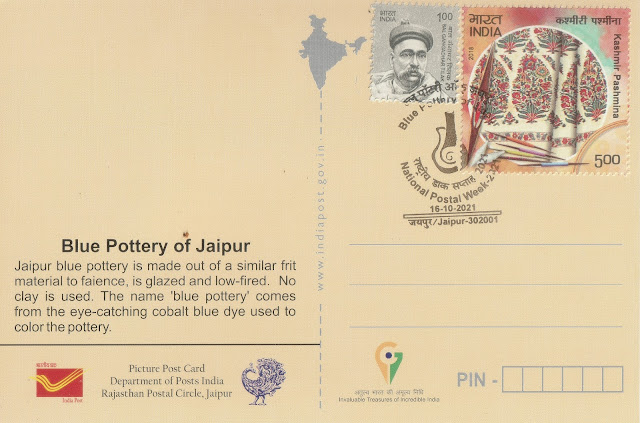Blue pottery of Jaipur can be easily recognized by predominance of blue colour on them and widely recognised as a traditional craft of Jaipur, Rajasthan. The brilliance of blue created from cobalt oxide is striking and is the key shade to create the visual appeal of these items.
The blue pottery products are quite light in weight. The surface shines but the shine is less glossy. The entire product is covered with decorative motifs and filled entirely with colours. The adherence to hand painting has lent a high level of delicacy to this art and has contributed to the designs looking fresh and full of life.
Inspired more from nature, the pottery is adorned with profusely animals, birds and flowers with a hint of Persian geometric design in the compositions. The traditional motifs like tessellating type of jaali and the stylized floral designs also reflect their Persian origins.
Man Singh I was the first to bring the art of blue and white to Jaipur subsequent to his interactions with the Mughals and through his campaigns in Afghanistan. The production of the blue pottery of Jaipur in Rajasthan involves eleven steps .
The 'dough' for the pottery is prepared by mixing the ingredients. No clay is used in the process (Preparation of dough). The key ingredients used in making this pottery are Dough (Quartz powder), Saaji (soda bicarbonate), Multan mitti (Fuller’s earth), Kaatira gond (natural resin), Safed laanch (glass), Glaze – Sindoor (red lead), Suhaga (Borax powder) and Crushed glass.
A vitreous glaze is prepared to coat the body of the product and to give it a shine after firing(Glaze making). Then the required ware is fabricated in a mould (locally known as Bharan nikaalna).
Once the item is dry, it is turned on the wheel and a smooth rounded base is added to it, to give a finish to the shape (Pendi lagana). Product is then smoothened with sandpaper and wet dough (Rezmaal ka kaam). White base colour is applied now by mixing Quartz Powder and white glass (Engobe/Astaar lagana).
Motif designs are then completely hand painted with brushes made of hair from the tail of a squirrel (Rangaai) and then colours are applied.
Following materials are used for colouring:
- White colour - Powdered white glass and Quartz powder
- Light blue-Cobalt oxide
- Blue-Copper Oxide
- Green-Chrome Oxide
- Dark brown-Manganese
Once the potter has enough products, he begins the process of firing (Bharana/bhatti ko jamana). Traditionally wood fire kiln is used to fire the product(Pakana). Babool wood is used for this purpose as it has tendency to retain much heat. Unlike other pottery from the region, it is fired only once.
The biggest advantage is that blue pottery does not develop any cracks, and blue pottery is also impervious, hygienic, and suitable for daily use. Most of the items comprise of domestic kitchenware such as cups, plates, flower vases, tea pots, urns, tea coasters, napkin holders, bread holder.
GI Tag Registration Date : 10 July 2008
GI Tag Number : 66
Certificate Number : 74
Geographical Area : Rajasthan
Special Cover Release Date : 18 August 2021
Cancellation : Jaipur 302 001
Type : GI Tag Cover
This cover is issued with 7 other covers as a Presentation Pack titled "Special Cover & Cancellation - Geographical Indications of Rajasthan" priced at Rs. 100 per pack. Total quantity issued 2500 Nos.
Enlarged View of Illustration
India post has issued few stamps on Blue Pottery. Images are furnished below
Extracted from Mixed Sheetlet
"Happy New Year - Splendours of India"
Issued on 01 January 2017









No comments:
Post a Comment